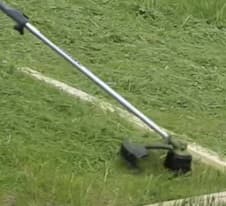As an Amazon Associate, this site earns commissions from qualifying purchases. For more information click here.
To answer the question right off, yes, electric and gas weed eaters can and do overheat. There are many reasons why this happens, but I will show you the most likely causes, the solutions and preventive measures.
A weed eater can overheat due to an overworked engine, clogged filters or a dirt buildup. A blocked carburetor or cooling system are also possible causes.
Overworked Engine
This is the most common reason and also the easiest to fix. If the engine motor is pushed over the limit, it will overheat or emit smoke.
Solution. The fix is to let the motor rest for a few minutes. Wait until the weed eater (or string trimmer if you prefer) is cool to the touch and then you can resume.
Do not use the weed eater if it’s smoking. Turn it off and unplug (if electric) and check for signs of damage.
As you check the engine, don’t forget to look into the spark plug. Problems with spark plugs can lead to overheating too.
You can prevent this by using weed eaters only to their specified capacity. This information will be in your user manual and the manufacturer website.
In general, weed eater capacity can be broken down as follows:
- Gas weed eaters: for heavy, thick brush and large yards
- Electric weed eaters: for the average sized yard
- Battery-powered weed eaters: for small yards and light trimming
This is a general guide. Some electric string trimmers like the Black and Decker Besta510 can handle thick grass, so it depends on the model you’re using.
Cooling System Issues
The cooling system as you might expect, is designed to prevent overheating. It uses a flywheel to draw heat out and pull cool air in.
The cooling system can get clogged with debris over time, which traps heat and prevents cool air from getting in.
Solution. Clean the cooling system regularly to avoid dirt buildup. Usually it is located behind the drive shaft, but check your owner’s manual to be sure.
Once you get access to the cooling system, you will see the cooling fins, flywheel and other components. Clean thoroughly.
Clogged Carburetor
Debris, varnish and other gas-related substances eventually make their way into the carburetor. If the carburetor is heavily clogged, you’ll have a hard time starting the engine. Even if the engine starts, it will overheat quickly.
Solution. Use a carburetor cleaner like Star-bil to eliminate all traces of grime. The carburetor is usually located behind the air filter so you have to remove the filter first.
Remove the carburetor from the weed eater. Spray with the cleaner as directed on the product instructions.
To remove all the grime, you have to take the carburetor apart. Spray each piece and look for signs of damage. If there are broken parts, you’ll need a carburetor kit to replace them.
Disassembling a carburetor is not for everyone. If you don’t feel comfortable doing this, take your weed eater to a service center.
If you want to give it a try, this video shows you how it is done.
Adjust the Carburetor
If cleaning the carburetor does not work, try adjusting the screws. If you just finished cleaning the carburetor, put it back in place and make the adjustment.
You will see 3 screws on the carburetor. Adjust these in increments and see how the engine responds. Keep making small adjustments because a slight change can have significant effects on the engine.
Dirty Air Passages
Weed eaters have filters which work with the cooling system to prevent the engine from overheating.
These air filters screen out dirt and debris so air can go through the engine. But as time passes, the filters accumulate dirt and get clogged. Temperature rises inside the weed eater and causes it to overheat.
Solution. Washing the filter with water is all you need to do. Most weed eater filters are located on the back of the engine, held in place by screws.
Remove the screws and take the air filter out. Brush off as much of the dirt as possible.
Mix hot water with dish soap in a bucket. Put the filter in the soapy mix for a few minutes. Gently squeeze the filter to remove any remaining debris. Be careful not to tear the filter.
Let the filter dry before putting it back in the weed eater, Replace the screws.
Wrong Fuel Mixture
Most weed eaters have a 2-stroke engine which requires a mixture of oil and gas. An incorrect ratio can lead to overheating or the engine might not start at all.
Solution. Most 2-stroke weed eaters use a 40:1 ratio or one gallon of gas for every 3.2 ounces of engine oil.
You’ll need good quality engine oil for weed eaters. I recommend the Echo Power Blend because just a little bit goes far.
A few models might use a 50:1 or 32:1 ratio, so consult the operating manual if you’re not sure.
Some of the newer string trimmers run on a 4-stroke engine. These models have separate tanks for gas and oil. Do not mix the fuel.
Too Much Fuel
Too much gas causes fuel to burn at a higher temperature which leads to overheating. Smoke or leaking oil are signs there is too much fuel in the weed eater.
Solution. Let the engine run for a few minutes to burn the excess fuel. When the smoke dissipates, turn the engine off and allow it to cool down.
Turn the engine back on. It should run normally now. If it is still too hot, you have to replace the fuel with the proper ratio of gas and oil.

Clogged String Head
Weed eaters collect weeds, grass clippings and debris when used. Some of these may end up in the shaft and cause the string head to overheat.
Solution. Turn the weed eater off. Check the string diameter and make certain it is compatible with the string head. You can find this information in the manual.
If the string size is correct, examine the spool. It might be covered with debris or twisted. Remove the spool to untangle it and clear the debris away.
Why Electric Weed Eaters Overheat
An overloaded motor is the most common reason why electric string trimmers overheat. This happens when the motor is working beyond its capacity.
The solution is simple: do not use the trimmer beyond its stated capacity. For an average sized yard, electric weed eaters will work. But if you have to trim thick, heavy grass on a large area, get a gas model like the Sunseeker 26cc weed eater.
If the motor isn’t overloaded, check the wiring. Shorting, frayed wires, loose connections, mismatched voltage and other electrical problems can lead to overheating.
The solution is to repair the wiring and electrical connections. Do not use the machine until all the issues have been resolved.
Why Battery Powered Weed Eaters Overheat
This usually happens when the weed eater tries to trim very thick grass. The battery is unable to handle the demand and starts to run hot.
The same thing happens with gas and electric string trimmers. If the engine or electric motor is overloaded, the temperature rises and the system gets too hot.
Battery-powered weed eaters are designed for light trimming. Use it only for light grass and small areas.
If the battery is always running low, it is probably not fully charged. If it is, the heavy load drains the power quickly.
How to Prevent Weed Eaters From Overheating
While there are many reasons why string trimmers can run hot, there are ways to prevent it.
Let the weed eater rest. Give the engine time to cool down if you are trimming a lot of thick grass. If it’s no longer too hot to touch, you can resume.
Don’t use the trimmer if the weather is too hot. Rule of thumb: if it is too hot for you, it probably is too for the engine. Wait for the temperature to cool a little.
Perform regular maintenance. A lot of the reasons why engines overheat is related to clogging. By regularly cleaning your string trimmer, these problems can be avoided or minimized.
Use the weed eater as indicated. If the owner’s manual says it is only for light grass, use it only for that. If it can be used for thick weeds, you can safely use it for heavy duty work.

I love the outdoors and all the tools for maintaining gardens, yards and lawns. The only thing I am more passionate about is sharing what I know about garden and outdoor equipment.


